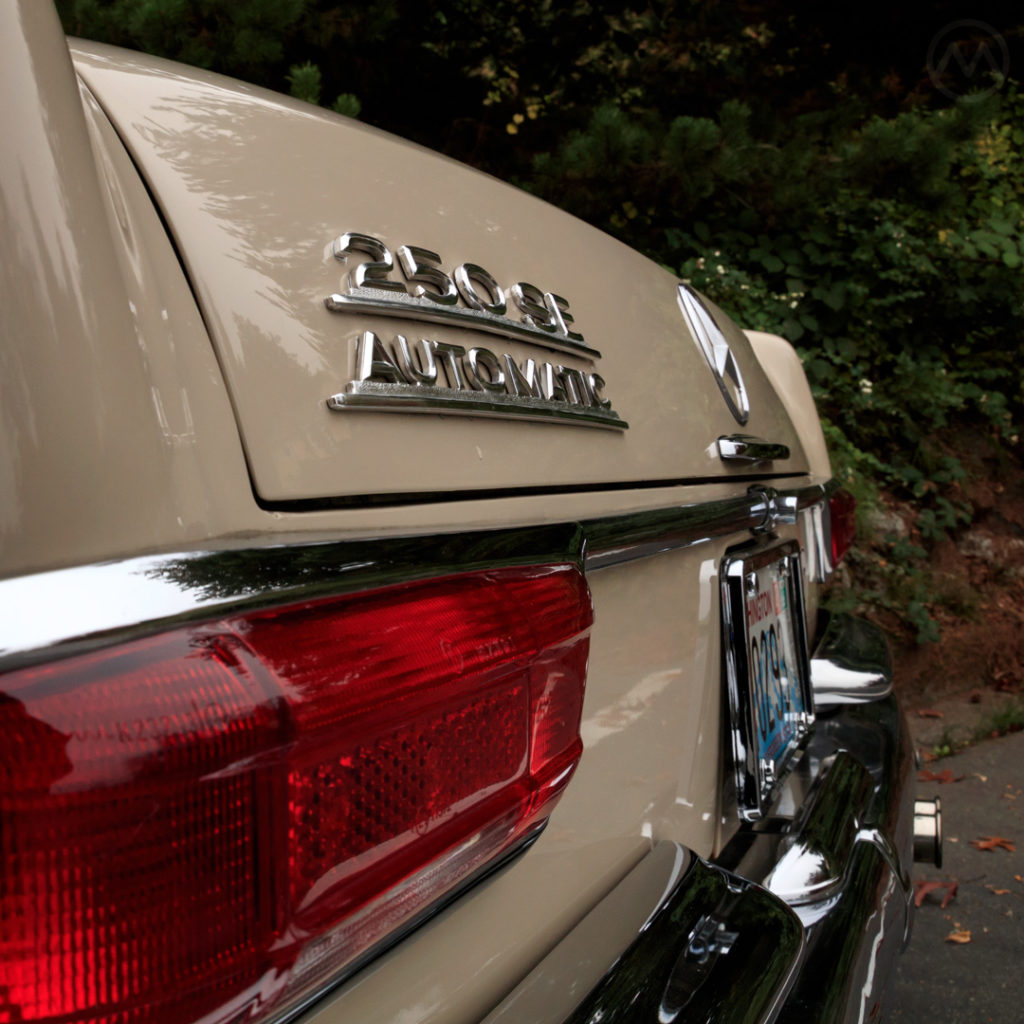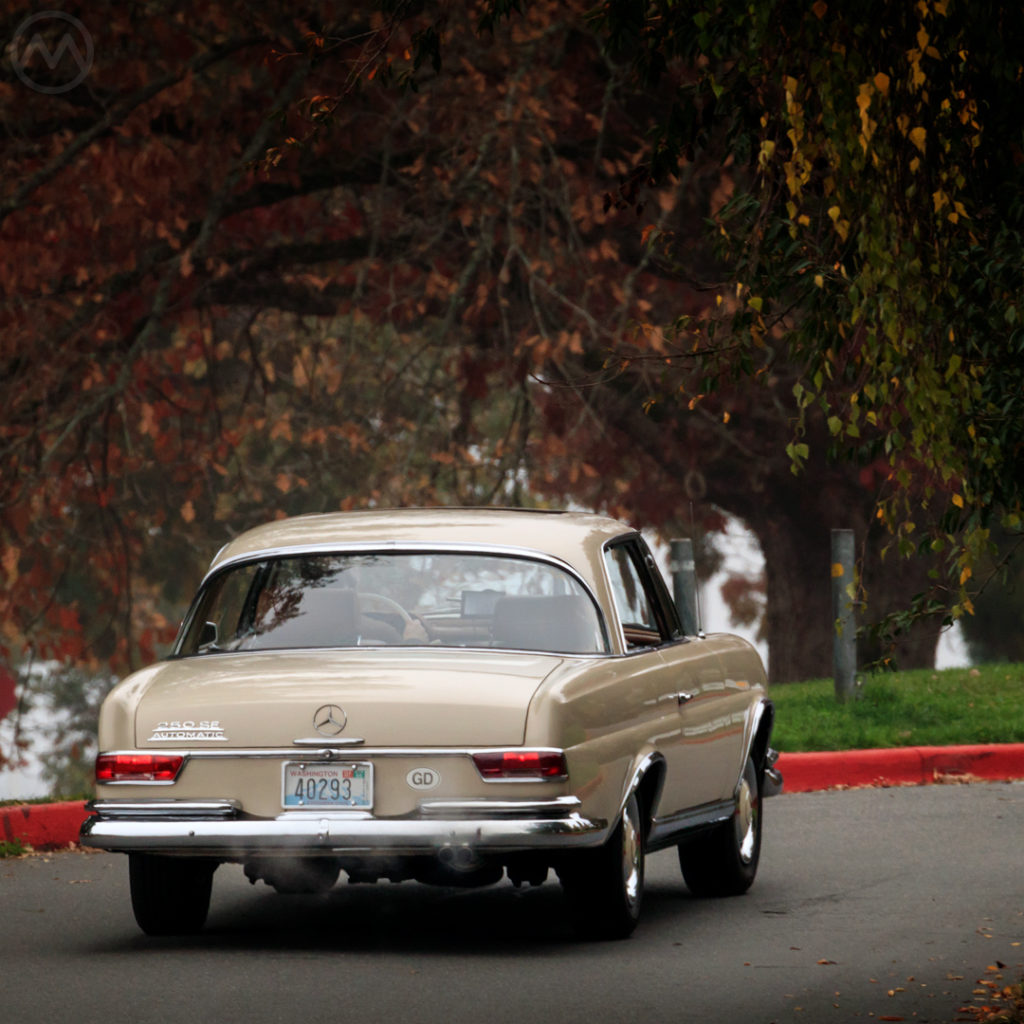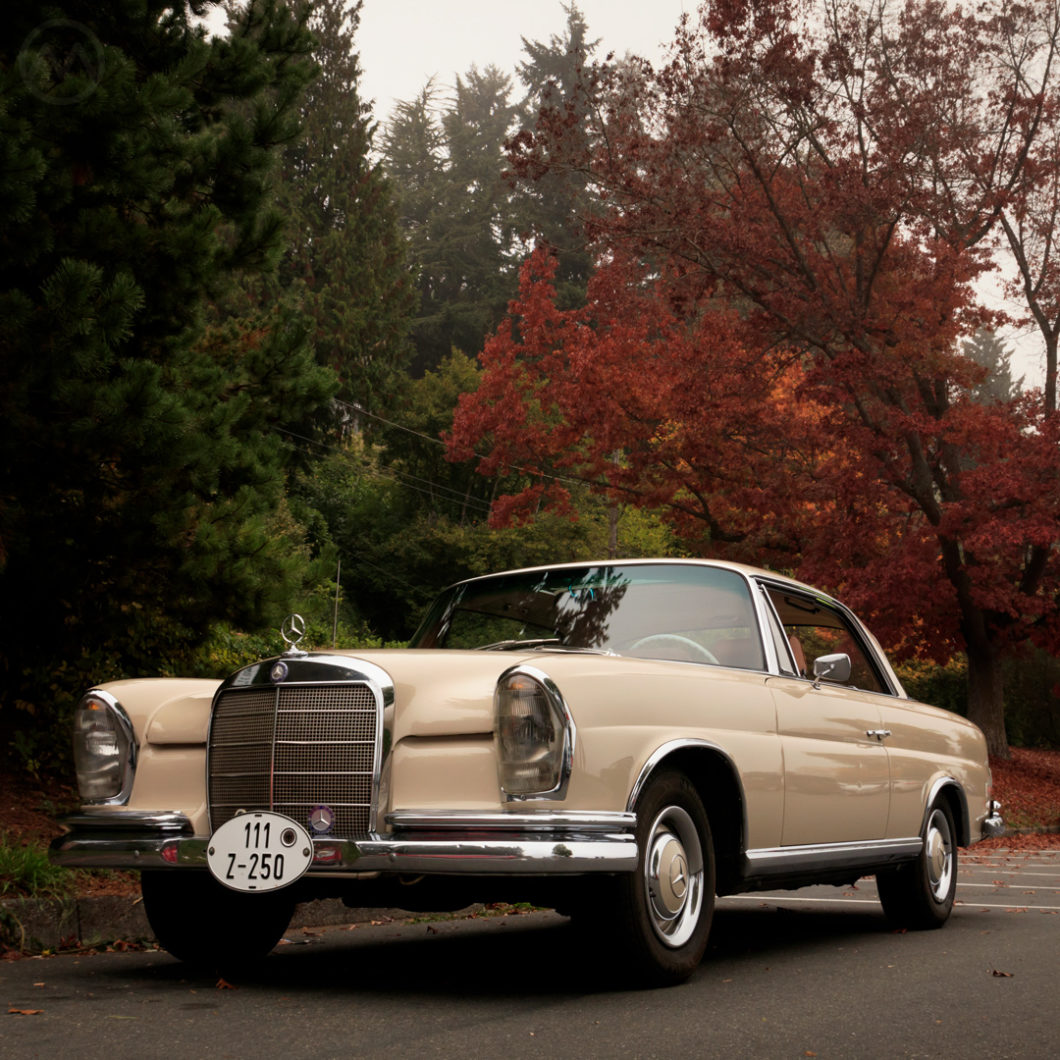Even in the long evolution of Mercedes-Benz style, few cars have looked as timeless as the W111/W112 coupes. They were designed 60 years ago, but they don’t look like a car of 1960.
The coupes were glamorous cars for plutocrats, but their origin was more humble. Mercedes-Benz spared no expense on engineering, but in the 1950s opted for a platform-sharing approach to keep model costs under control. The coupes were based directly on the W110/W111 “Heckflosse” sedans, but looked different on the surface.
The coupes were produced for ten years from the original 220SE Coupe (February, 1961) and Cabriolet (September, ’61) to the last 280SE 3.5 V8s (retired in July, 1971) with the six-cylinder 250SE seen here right in the middle – produced from September 1965 to December of 1967. They didn’t change much visually in that time – but the rest of the Mercedes-Benz lineup did.
One reason why these coupes aged so well is that later Mercs drew directly on them for stylistic inspiration. Paul Bracq’s basic lines and style, first sketched as far back as 1957, were subsequently applied to the huge 600 in 1963, the W108/109 in 1965 and the Strich Acht W114/115 in 1968.
By then the big coupes were on their way out, but they weren’t directly replaced until 1981’s C126 Coupe. Their long life and rolex-like quality meant they never really went out of fashion.
Plebian and Patrician
The story really starts with the creation of the “Ponton” (German for “Pontoon”) Mecedes models of the 1950s, developed under Fritz Nallinger and Béla Barényi and styled by Karl Wilfert. These unibody cars replaced the pre-war W136 170-series and quickly became the most popular Mercedes models ever. Mercedes had built 83,000 170s from 1945-55, but built more than 440,000 of the lower-end W120/121 Ponton from 1953-62.
Contrast that with annual sales of less than 6,000 cars for the non-Pontons, the big Adenauer and the 300/190 SLs and it’s easy to see that economies of scale were terrible on the “Premium” Mercs. But, then, they did sell for a king’s ransom – in tiny quantities.
The Pontons were five years old in 1958 and already work was underway to replace them with an evolutionary version of the platform. To rationalize the lineup, both the W188 300s/300sc coupe and convertible and the SLs would migrate to platforms shared with the upcoming “W111” Ponton replacement and its eventual premium derivative, the W112.
The W111 arrived in the fall of 1959 was again styled by Wilfert and retained Barényi’s excellent crash engineering – decades ahead of its time. Although not an official nickname, the W111 became forever identified by the modest but very American tailfins at the back. In English it’s usually called the “Fintail,” in German, “Heckflosse.”

There would be three basic fintails – the four-cylinder, downmarket W110, the mainstream W111, and the high-end W112 (forerunner to the “S class,” though it was not called that at the time), all close kin under the skin but with various engineering and powerplant differences (W112s had air suspensions, for example). Both the W111 and eventual W112 (1962-67) would get coupes and convertibles to replace the old W188s, which had been dropped at the end of 1958 thanks to slow sales.
The goal here was to provide a coupe and cabriolet that felt as exclusive as the old cars, but which could be sold in much larger volumes at much lower unit costs. Unlike the Ponton Coupes, they also had to be slightly more distinct from the sedans – these cars would be aimed at Mercedes’ most well-heeled consumers – they couldn’t look like 2-door sedan versions of a Stuttgart taxi.
Enter, Paul Bracq
By the time the “Heckflosse” sedans were launched, the styling for the Coupe version was almost finished.
Educated at the École Boulle in Paris, Paul Bracq had briefly been an assistant to designer Philippe Charbonneaux (Renault R8, R16, and more) in France, working on bespoke designs for Pegaso and a coachbuilt Citroën before serving his compulsory Military service. Germany was still under occupation at that time, and that’s where Bracq served.
After driving a 300 “Adenauer” and being assigned to a staff garage full of German cars at the Air Force Base where he worked, Bracq got in touch with Mercedes’s PR department and showed them some sketches.
He wanted to work at a place that was growing, and makes like Pegaso and Delahaye, for whom Charbonneaux design cars, seemed on their last legs. Days later he was summoned before Wilfert, who was so impressed with Bracq that he offered him a job as soon as his military service was over.
The Algerian war kept Bracq in uniform for longer than expected, but he joined Mercedes in 1957, working under Wilfert and long-time stylist Friedrich Geiger. He would stay at Daimler-Benz for a decade, and one of his first tasks was designing the new coupes – but it was a very fertile period. Not only were these coupes materializing, but so were the W113 “Pagoda” SL and the Grosser 600.
W111 Coupe & Cabrio
There were considerable constraints on what could be done to alter the W111 into a coupe and cabriolet. It had to retain the wheelbase of the sedans in ordered to provide true four-place seating. That would prevent it from overlapping with the 190SL (and its planned replacement) and expand their appeal from the old W188s. The old coupes had a nominal back seat, bigger than an MGB/GTs but not a fun place to be, and the old Convertible had none.
The fintail’s defining characteristic forever linked them to the era in which they were designed, but Bracq’s coupes were different. Like the sedans, they also possessed a transatlantic influence in proportions and the airy hardtop greenhouse. The roofline echoed the 1955-56 Chrysler and Imperial 2-door hardtops, but was taller and slimmer.

Out back, the coupes had only the most subtle echo of fins, with the rear falling away in a steep slope with no sharp edges. Up front, they were almost identical to the W111 sedans, but looked a little lower slung thanks to the long airy hardtop. They were of their period, but seemed ageless – at once modern and traditional.
The look was sober overall but stayed fresh as he applied similar treatments to subsequent Benzes (W108, W114/115).
The W111 models used at first a 2.2L straight six (220SE, 1961-65)) then a 2.5L as seen here (250SE, 1965-67), then a 2.8L (280SE, 1967-71), and finally a 3.5L V8 (280SE 3.5, 1969-71). Along the way, there was also a W112 version of the car. Cosmetically it was nearly identical, but carried a 3.0L six and finer appointments.
The 250SE
Like S-class coupes today, all of these coupes were exclusive cars but not quite exotics. The 250SE ran to a bank-manager-summoning $9,500US in early 1966, an amount that put it far beyond the cost of American luxury cars but far below exotics from Aston-Martin, Bentley, or Maserati.
For that hefty sum you got one of the best cars in the world – meticulously assembled (in part, by hand), luxuriously appointed, and packed with rock-solid engineering.
The 250SE used the 2.5L M129 engine, an SOHC version of the M180 six that dated back to the 1950s, now with Bosch fuel injection. Disc brakes were standard on all four wheels. The standard transmission was a four-speeder, but most North American cars (including this one) were automatics. This wasn’t a particularly fast combination but they were built for luxury and solidity, not speed, and they had those qualities in abundance.
The 3-liter W112 300SE was faster, but its performance was blunted by weight (none of these cars were “light”). In 1967, both the 250SE and the 300SE gave way to the 2.8L 280SE. Intended as an improvement on the 250, the 280 actually ended up faster than the 300SE as well, and supplanted both.
The Six-cylinder 280SE was joined by the ultimate W111 – the V8 280SE 3.5 in November, 1969. Naturally that car gets the most attention today and the V8s were highly prized even when they were just used cars in the late 1970s and 1980s. 5,259 250SE coupes were built the 27 months it was in production, about 48 a week, plus 954 of the very rare cabriolets.
Broadly similar but more modern W114 hardtop coupes – the 250C/CE were introduced in 1969. They were not as prestigious as the old W111s, but they offered a similar experience to the departed 250SE in a slightly more humble package.

The W111 Coupe was finally dropped in 1971 to make way for the C107, a stretched version of the R107 SL. The C107 was another attempt to make the SL a little more economical to build, and to eliminate the last vestiges of hand-crafted cars on the assembly line. The W111 coupe and convertible were more rational than the almost-totally-hand-made W188, but by 1971 they too were low-volume, high-cost niche cars.

